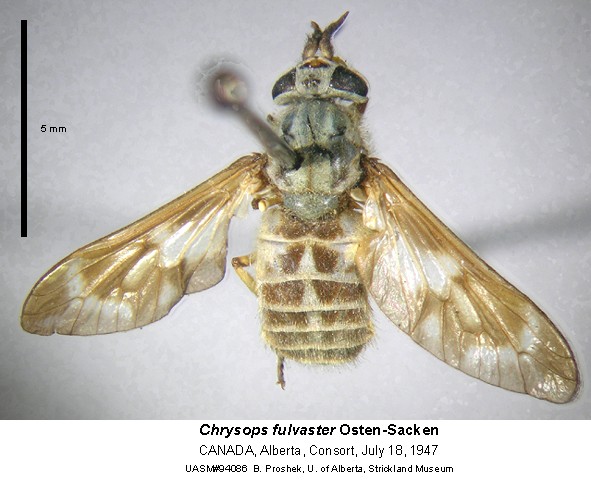« Back to UASM94083
Species Details
Chrysops fulvaster
University of Alberta E.H. Strickland Entomological Museum Read more about this collection »
SeasonalityChrysops fulvaster is most readily captured in late June or July.
IdentificationTeskey (1990) records that female C. fulvaster are largely dull yellow and brown, with highly mottled wings. On the head, the antennae are largely yellow, except for the darkened apical flagellomeres, and the scape is more swollen than the other antennal segments. The frons is wider than high, and more wide below; gena partly black; palpi yellow; and the clypeus is glossy yellow with a pruinose (powdery) band. The thorax has yellow hairs, with longitudinal stripes down the scutum and pleura. The legs are largely yellow, except for blackened front femora (Cole, 1969). The abdomen dorsally is grayish yellow with black spots below the scutellum; the tergites in succession posteriorly have pairs of large brown spots with yellower triangles between them. Males are smaller and much darker, but similarly patterned (Teskey 1990).
Chrysops fulvaster can be easily separated from all other Chrysops by the combination of the median prunes band on the clypeus, the scape being swollen relative to the other antennal segments, and light infuscation (darkening) along the entire posterior border of the wings (Teskey 1990).
Scientific Name
Chrysops fulvaster
Habitat
Small sluggish streams and swampy areas of relatively fresh water in western prairies and plains (Teskey 1990).
Seasonality
Chrysops fulvaster is most readily captured in late June or July.
Identification
Teskey (1990) records that female C. fulvaster are largely dull yellow and brown, with highly mottled wings. On the head, the antennae are largely yellow, except for the darkened apical flagellomeres, and the scape is…
Teskey (1990) records that female C. fulvaster are largely dull yellow and brown, with highly mottled wings. On the head, the antennae are largely yellow, except for the darkened apical flagellomeres, and the scape is more swollen than the other antennal segments. The frons is wider than high, and more wide below; gena partly black; palpi yellow; and the clypeus is glossy yellow with a pruinose (powdery) band. The thorax has yellow hairs, with longitudinal stripes down the scutum and pleura. The legs are largely yellow, except for blackened front femora (Cole, 1969). The abdomen dorsally is grayish yellow with black spots below the scutellum; the tergites in succession posteriorly have pairs of large brown spots with yellower triangles between them. Males are smaller and much darker, but similarly patterned (Teskey 1990).
Chrysops fulvaster can be easily separated from all other Chrysops by the combination of the median prunes band on the clypeus, the scape being swollen relative to the other antennal segments, and light infuscation (darkening) along the entire posterior border of the wings (Teskey 1990).
Life History
Not much is known of C. fulvaster specifically. The eggs are laid in single-tiered masses with overlapping shingled rows of eggs, often under leaves of Potamogeton and Sagittaria (Teskey 1990). If the development…
Not much is known of C. fulvaster specifically. The eggs are laid in single-tiered masses with overlapping shingled rows of eggs, often under leaves of Potamogeton and Sagittaria (Teskey 1990). If the development times can be assumed to be similar to other Chrysops, the larvae take 10 months or longer to mature in Canada, but can have several generations per year southwards.
Conservation
Fairly common. Adults can be locally quite abundant.
Diet Info
Adults feed on flower nectar, and females take blood meals for egg production; nothing is known of the dietary habits of the larvae.
Range
The southern parts of British Columbia, Alberta, and Saskatchewan, and southward to California and Oklahoma.
References
Author
Cole, F. R.
Title
The Flies of Western North America.
Publication Date
1969
Pages
693
Author
Teskey, H. J.
Title
The horse flies and deer flies of Canada and Alaska. Diptera: Tabanidae.
Publication Date
1990
Pages
381
Specimen Information
There are 9 specimens of this Species.
UASM94077 - Chrysops fulvaster
University of Alberta E.H. Strickland Entomological Museum
Place CollectedCanada: Alberta, Medicine Hat
Collected ByStrickland, E. H.
Date Collected1950-07-08
UASM94078 - Chrysops fulvaster
University of Alberta E.H. Strickland Entomological Museum
Place CollectedCanada: Alberta, Medicine Hat
Collected ByStrickland, E. H.
Date Collected1950-07-08
UASM94079 - Chrysops fulvaster
University of Alberta E.H. Strickland Entomological Museum
Place CollectedCanada: Alberta, Medicine Hat
Collected ByStrickland, E. H.
Date Collected1950-07-08
UASM94080 - Chrysops fulvaster
University of Alberta E.H. Strickland Entomological Museum
Place CollectedCanada: Alberta, Consort
Collected ByStrickland, E. H.
Date Collected1948-07-20
UASM94083 - Chrysops fulvaster
University of Alberta E.H. Strickland Entomological Museum
Place CollectedCanada: Alberta, Medicine Hat
Collected ByStrickland, E. H.
Date Collected1956-07-08
UASM94084 - Chrysops fulvaster
University of Alberta E.H. Strickland Entomological Museum
Place CollectedCanada: Alberta, Consort
Collected ByStrickland, E. H.
Date Collected1947-07-18
UASM94085 - Chrysops fulvaster
University of Alberta E.H. Strickland Entomological Museum
Place CollectedCanada: Alberta, Consort
Collected ByStrickland, E. H.
Date Collected1943-07-17
UASM94086 - Chrysops fulvaster
University of Alberta E.H. Strickland Entomological Museum
Place CollectedCanada: Alberta, Consort
Collected ByStrickland, E. H.
Date Collected1943-07-17
UASM94087 - Chrysops fulvaster
University of Alberta E.H. Strickland Entomological Museum
Place CollectedCanada: Alberta, Consort
Collected ByStrickland, E. H.
Date Collected1943-07-17
